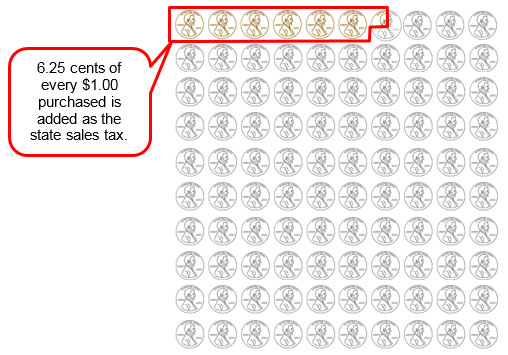
In the previous section, you used models to show how the same part of a whole can be represented with both a fraction and a decimal. In this part of the lesson, you will focus on how you can represent the same part of a whole with equivalent decimal numbers or percents. Recall that a percent is a rational number that describes the number of parts per 100. For example, the Texas state sales tax rate is 6.25%. This means that for every dollar—or 100 cents—of a sale, 6.25 cents are added to the purchase total in order to pay a state sales tax.

![]() Use the sliders in the interactive below to show the relationship between a number written as a percent and the number written as a decimal. Click on the horizontal slider to change the tens digit in the percent and the vertical slide to change the ones digit in the percent.
Use the sliders in the interactive below to show the relationship between a number written as a percent and the number written as a decimal. Click on the horizontal slider to change the tens digit in the percent and the vertical slide to change the ones digit in the percent.
Use the interactive to create a model for the given percents. Copy and paste the table below into a word processing or spreadsheet program or app. Record the equivalent decimal number in the table. Use your table to answer the questions that follow.
Percent |
Decimal Number |
25% |
|
63% |
|
78% |
|
18% |
Percent |
Decimal Number |
25% |
0.25 |
63% |
0.63 |
78% |
0.78 |
18% |
0.18 |

Interactive popup. Assistance may be required.
The decimal number has the same digits as the percent, but instead of a percent sign, there is a decimal point in front of the digit that was in the tens place of the percent.
Interactive popup. Assistance may be required.
The tens digit of the percent is the same as the tenths digit of the decimal number.
Interactive popup. Assistance may be required.
The ones digit of the percent is the same as the hundredths digit of the decimal number.
Interactive popup. Assistance may be required.
Divide the percent by 100 to obtain the equivalent decimal.
Interactive popup. Assistance may be required.
Multiply the decimal number by 100 to obtain the equivalent percent.
A percent is a part of the whole given in terms of the number of parts per 100. How does the definition of a percent appear in the relationship between a percent and its equivalent decimal number?

If the percent is greater than 100%, such as 245%, how will you convert the percent to a decimal number?
In a recent year, the cost of gasoline showed a 29.6% increase in price. What is this number represented as a decimal?
Interactive popup. Assistance may be required.
If produce is being sold at a 20% discount, then the sale price will be 80% of the original price. Generate an equivalent decimal number for 80%, and then compare it to the decimal number for the sale price of milk, 0.9.
Interactive popup. Assistance may be required.
To generate an equivalent percent from a decimal number, multiply by 100.